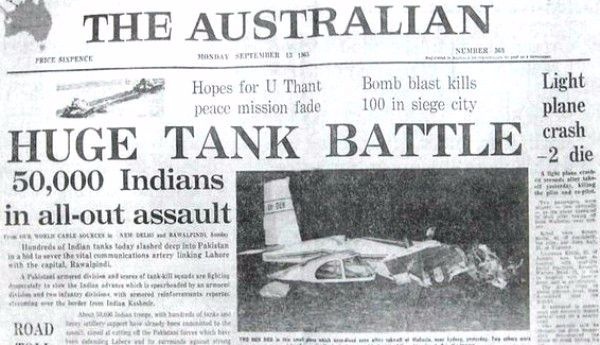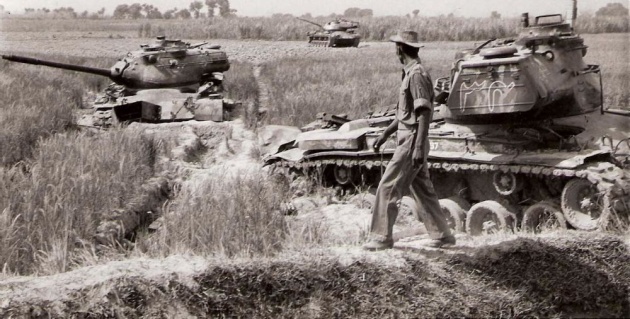 The Indo-Pakistani War of 1965 saw the Indian and Pakistani Air Forces engaged in large-scale aerial combat against each other for the first time since the independence of Pakistan in 1947. The war took place during the course of September 1965 and saw both air forces conduct defensive and offensive operations over Indian and Pakistani airspace. The aerial war saw both sides conducting thousands of sorties in a single month.[10] Both sides claimed victory in the air war; Pakistan claimed to have destroyed 104 aircraft against its own losses of 19, while India claimed to have destroyed 73 enemy aircraft and lost 35 of its own.[4] Despite the intense fighting, the conflict was effectively a stalemate.
The Indo-Pakistani War of 1965 saw the Indian and Pakistani Air Forces engaged in large-scale aerial combat against each other for the first time since the independence of Pakistan in 1947. The war took place during the course of September 1965 and saw both air forces conduct defensive and offensive operations over Indian and Pakistani airspace. The aerial war saw both sides conducting thousands of sorties in a single month.[10] Both sides claimed victory in the air war; Pakistan claimed to have destroyed 104 aircraft against its own losses of 19, while India claimed to have destroyed 73 enemy aircraft and lost 35 of its own.[4] Despite the intense fighting, the conflict was effectively a stalemate.
The aerial phase of the war began on 1 September 1965 when the Indian Air Force (IAF) responded to an urgent call for air strikes against the Pakistani Army, which had launched an attack known as Operation Grand Slam. The IAF's 45 Sqn was tasked to carry out Close air Support missions in support of Indian troops. The squadron had recently been moved from Pune to Pathankot, after a merger of No 220 Sqn into it, under the command of Sqn. Ldr. S.K. "Marshal" Dhar. Three missions of four aircraft each were tasked, with the first wave taking off at 1719 hours.[15] These strafed Pakistani positions and attacked Pakistani tanks and ground targets, though a lot of damage from "friendly fire" was also reported later on. The Indian aircraft were intercepted by two Pakistan Air Force (PAF) F-86 Sabres, flown by S/L Sarfraz Rafiqui of No 5 Sqn and F/L Imtiaz Bhatti of No 15 Sqn. In the ensuing dogfight four IAF Vampires were lost, one from the first wave and three from the second.[16][17] After this, the IAF immediately withdrew about 130 Vampires, together with over 50 Ouragons, from front-line service.

On 2 September, both sides flew in support of their ground forces, however no major aerial engagement was observed.[19]
The appearance of the Sabres necessitated a move by the IAF to send the Folland Gnat fighters to the forward base of Pathankot. IAF used Mysteres flying at slow speed as bait to lure Sabres to attack where the waiting Gnats will take them on. Two sabres were scrambled but one had to turn back without entering the fight when the pilot couldn't jettison the fuel tanks. The other one flown by Flt Lt Yusaf Ali Khan, spotted the IAF planes and tried positioning himself behind them before attacking. Just as he got his cross-hairs on them he felt thuds on his own jet, as he was surrounded in a cloud of Gnats repeatedly being attacked. A Lockheed F-104 Starfighterlurking in the area was pointed to the dog fight by base control along with scrambling another one from base. The first Starfighter crossed through the dog fight at super sonic speed. The Gnats after scoring a kill started egressing. IAF's Squadron Leader Trevor J. Keelor of No. 23 Squadron claimed to have shot down the F-86 Sabre on that day (September 3), claiming the first air combat victory for the IAF of the war and subsequently received the Vir Chakra and the title of 'Sabre Slayer'. However the sabre he 'shot down' was flown in badly damaged condition and somehow rough landed back at the base. The Sabre pilot, Flt Lt Yusaf Ali Khan, was given Sitara-e-Jurat for surviving dog fight with six Gnats (while his wingman was ordered to leave since he couldn't jettison his fuel tanks) and bringing the damaged Sabre back home. In the same incident, an IAF Gnat pilot was overheard warning others of the incoming Starfighter. [20] Also, a Gnat piloted by Squadron Leader Brij Pal Singh Sikand, mistakingly landed at an abandoned airstrip in Pasrur, when he thought he had safely crossed the border. His takeoff attempt was aborted due to presene of a Pakistan army jeep on the runway. He was taken POW and later handed over to PAF. A Lockheed F-104 Starfighter flown by Flt Lt Hakimullah Khan chasing in at super sonic speed was also credited with forcing the Gnat down.[20][21] This Gnat is displayed as a war trophy in the Pakistan Air Force Museum, Karachi.[20] after it was flown from Pasrur by Sqn Ldr Saad Hatmi who flew the captured aircraft back to Sargodha, and later tested and evaluated its flight performance, was of the personal view that Gnat was no 'Sabre Slayer' when it came to dog fighting.[20]
On 4 September, an F-86 Sabre was lost. The PAF claimed the cause to be friendly ground fire[22] while the IAF claimed to have shot it down.
Rafiqui was shot down over Halwara on 6 September, while Bhatti ended the war with 34 combat missions to his credit, the maximum combat missions flown by any pilot during the war.[23]
Indian Folland Gnat on display at the PAF Museum Gallery.
During the conflict, the Pakistani F-86 Sabre Flying Ace, Muhammad Mahmood Alam shot down seven Indian aircraft including claims of two as 'probable'. Five Hawker Hunter aircraft were shot down in one minute, of which four were brought down in 30 seconds.[24][25][26][27][28][unreliable source?] However, his claims were never confirmed by the PAF and are referred as obvious fake[29]
On September 6, the Indian Army crossed the border at Lahore to relieve pressure on the Chamb Jaurian sector. On the evening of the same day, the PAF responded with attacks on Indian airfields at Pathankot, Adampur and Halwara. The attack on Pathankot was successful, while the attacks on Adampur and Halwara were failures. The IAF lost almost ten aircraft on the ground at Pathankot. The Adampur strike turned back before even reaching Adampur while at Halwara two of the three attacking raiders were shot down for the loss of two Indian Hunters in air combat. Both the Indian pilots survived as they ejected over their base, whereas the intruding Pakistani pilots were killed in action. This included the ace Squadron Leader Sarfaraz Rafiqui who had shot down two Vampires on 1 September.[30] Before being shot down, Rafiqui is credited with shooting down the first of the Hunters.[30] He was later posthumously awarded the Sitara-e-Jurat for the Chamb action and the Hilal-i-Jurat for the Halwara action.[31]
On 7 September 1965, the PAF parachuted 135 Special Services Group (SSG) para commandos[32] at three Indian airfields (Halwara, Pathankot and Adampur).[33] The daring attempt proved to be an "unmitigated disaster". Only ten commandos were able to return to Pakistan,[33] the rest were taken as prisoners of war (including one of the Commanders of the operations, Major Khalid Butt). At Halwara and Adampur these troops landed in residential areas where the villagers caught and handed them over to police.[33]
Also on 7 September, the IAF mounted 33 sorties against the heavily guarded PAF airfield complex at Sargodha.[34][35][unreliable source?] The IAF lost two Mysteres and three Hunters due to the defence mounted by the PAF's local squadrons. One of the Indian Hunter pilots, who ejected near Sargodha, was made POW and released after the war. One of the crippled Mysteres flying solo got involved in a dogfight with an F-104 Starfighter and each somehow shot the other down; the Pakistani pilot safely ejected, while the Indian pilot, Squadron Leader Ajamada B. Devayya, was killed.[30][36] Squadron Leader Devayya was awarded the Maha Vir Chakra for his bravery[37] 23 years later, after his feat was revealed by an author appointed by the PAF to write its official history of the 1965 war.[citation needed]
The seventh of September also marked the day when the PAF attacked IAF airfields in the Eastern Sector.[citation needed] During the PAF's raid on Kalaikunda, Indian pilot Flight Lieutenant A T Cooke engaged four Pakistani Sabres, shooting down one[36][38][unreliable source?] while flying at tree-top height[39] and making another a write off in the process.
The war lessened in intensity after 8 September, with occasional clashes between the IAF and the PAF. Both air forces now changed their doctrine from air interdictions to ground attack and concentrated their efforts on knocking out soft skin targets and supply lines, such as wagons carrying ammunition; and armoured vehicles. During the conflict IAF English Electric Canberras raided a few of the Pakistani bases. On 10 September one Mystere was downed by anti-aircraft fire in Pakistan but the pilot ejected safely.[40][unreliable source?]
On September 13, one PAF F-86 Sabre was downed while attacking a train near Gurdaspur and the pilot was killed. In another encounter the same day between PAF Sabres from Sargodha and IAF Gnats from No. 2 Squadron,[41] an Indian Gnat was shot down by a PAF F-86 Sabre flown by Flt Lt Yusaf Ali Khan[30] although the Indian pilot managed to eject safely. The other Gnat was engaged and damaged in air combat by Flt Lt Imtiaz Bhatti. The experienced pilot somehow managed to return to base, where according to All India Radio the Gnat's pilot later died of wounds sustained during the combat.[42] He was said to have brought his damaged aircraft back to base and to have died during landing. His funeral was attended by the Indian President.[43] Yusaf Ali Khan was credited with a kill whereas, Imtiaz Bhatti was credited with damaging the IAF Gnat[30] despite the later confirmation that the pilot died of wounds and the Gnat crashed during its landing attempt.[44] Later in the night of 13/14 September, Indian Canberras undertook the deepest penetration of Pakistani airspace of the war, attacking Pakistani bases around Peshawar and Kohat. Rather than bombing the Peshawer runway, however, IAF bombers mistook the mall road in Peshawer as the runway and dropped their bombs there instead. The Canberras were intercepted by a Pakistani F-104 near Lahore but they managed to evade the Starfighter and return home safely. They also had an encounter with F-86 Sabres, one of which fired at the Canberras, which sustained some damage.[30] A Pakistani F-86 Sabre also crashed while conducting an evasive maneuvere in an attempt to escape pursuit, from an escorting Gnat as it tried to defend the Canberra bombers; the PAF pilot was killed. The Gnat pilot, W/C Singh, was later credited with an aerial victory for this incident near Amritsar.[36] Later, one Pakistani B-57 was shot down by anti-aircraft fire over Adampur, although both of its crew managed to eject safely and remained POWs.[citation needed]
On 15 September, the PAF employed a number of its Lockheed C-130 Hercules transport aircraft as bombers, which proved unsuccessful; two of them were shot down by the IAF. The following day, one IAF Hunter[30] and a PAF F-86 Sabre[30] were shot down over Halwara. The IAF pilot was killed in the encounter, although the Pakistani pilot ejected and spent the rest of the war as a POW.[45] A Pakistani Cessna was also shot down that day, as well as an Auster observation aircraft.[36] On 18 September a Sabre was shot down by a Gnat over Amritsar; the matter was reported by the Collector, who had witnessed the entire dogfight.[36] The same day a Pakistani Sabre shot down a civilian Indian aircraft even after the civilian plane indicated its identity, the PAF pilot assuming it to be a reconnaissance mission. Years later, the PAF pilot wrote a letter to the Indian pilot's daughter to apologize for shooting down the aircraft.[46] The aircraft had been carrying the then Gujarat Chief Minister Balwant Rai and his family.[46][47][48][unreliable source?]
On 19 September, a Gnat[30] and two Sabres[36] were downed over Chawinda. One of the Sabres that were shot down was credited to Squadron Leader Denzil Keelor,[36] the brother of Trevor Keelor, who was credited with the first Indian aerial victory of the war.[49] The following day, another two Hunters[30] and an F-86 Sabre[36] were lost over Kasur, Pakistan.
The F-86 was vulnerable to the diminutive Folland Gnat, nicknamed "Sabre Slayer."[50] The Gnat is credited by many independent and Indian sources as having shot down seven Pakistani Canadair Sabres[a] in the 1965 war.[29][51] while two Gnats were downed by PAF fighters.
At one stage the IAF was operating 200 air missions simultaneously. IAF Folland Gnats of Nos 9 and 23 squadrons played a significant role in major air battles.
On 21 September, IAF Canberras carried out a daring daylight strike into Pakistan against the radar complex in Badin.[52] The raid proved to be successful. Under the command of Wing Commander Peter Wilson, six Canberras from No. 16 Squadron took off from Agra, over 1,000 km from Bladin and proceeded towards the radar complex at low level.[52] About 80 miles (130 km) short of the target, one Canberra climbed to an altitude of 10,000 feet in order to act as a decoy, before returning to base. The other five Canberras continued on towards the target. The flight then separated and four of the aircraft approached the target in two sections, each two minutes apart, at low level; before climbing to 7,000 feet from where they carried out bombing runs, dropping approximately 10,000 lbs of explosives. Wilson then approached from the south at an altitude of just 30 feet firing a salvo of 68mm rockets at the radar dome.[52]
On the same day a PAF F-104 intercepted a Canberra bomber on its way back from Sargodha and shot it down,[30] while one Hunter pilot who was the son of Chief of the Indian Army was shot down by anti-aircraft fire; he ejected and was taken POW.[53] The ceasefire was declared on the night of September 22, 1965.



